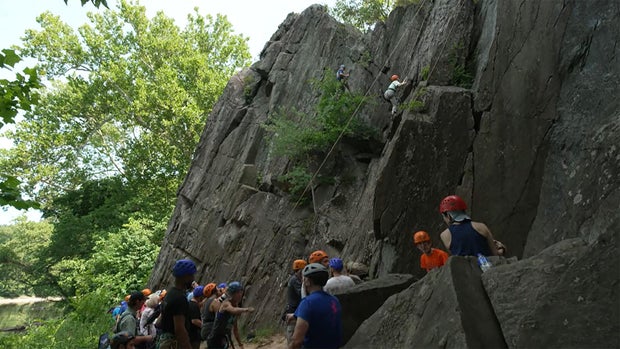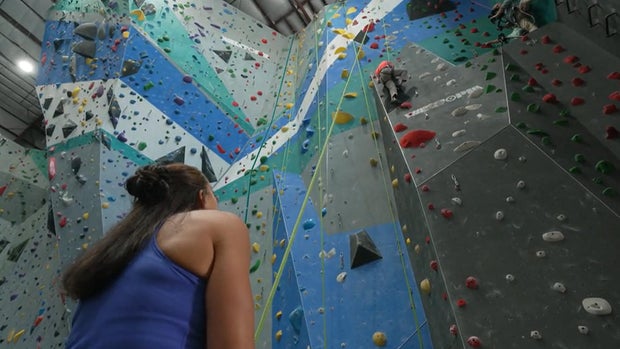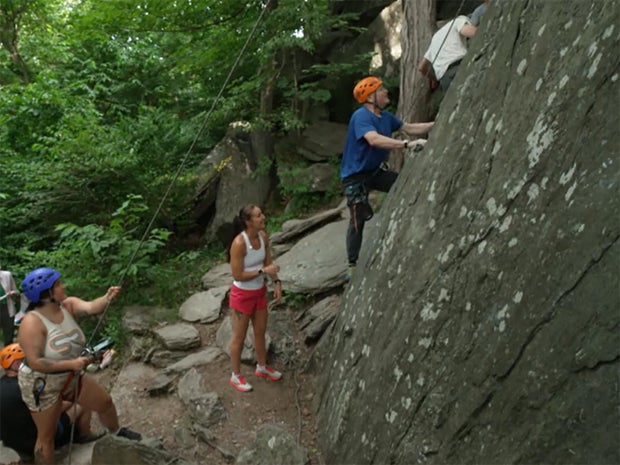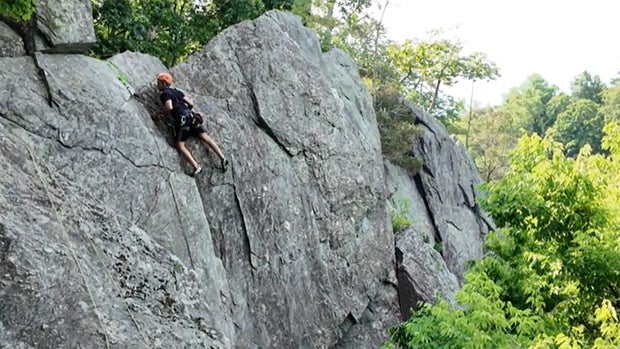We were amazed at what we saw on a sweltering summer day when a group of people with Parkinson’s disease took up rock climbing on Maryland’s Carderock Cliffs. Yes, rock climbing!
It’s all part of their therapy, says Molly Cupka, the no-nonsense instructor and cheerleader of this community of courageous climbers.
CBS News
She started this program, called UpENDing Parkinsons, as a nonprofit 12 years ago.
“There’s a lot of balance involved, mobility, strength, cardio, and then there’s the cognitive part, where you have to look at the hold and figure out how to get your body moving to achieve that hold,” she said. .
How often do they fall? “Falling is definitely part of climbing,” Cupka said. But they are never real fallbecause they wear a harness that provides a layer of safety. “You’re always on the rope. You fall, but you don’t fall far. We always say that if you don’t fall, you’re not trying hard enough!”
There is no cure for Parkinson’s disease, which usually affects mobility, coordination, balance and even speech. Jon Lessin was diagnosed in 2003. He was once an all-around athlete. About twelve years ago he retired as a cardiac anesthesiologist due to Parkinson’s disease. His daughter, Brittany, watched his steady decline until he discovered climbing walls as high as 65 feet!
“My dad has a hard time walking across the room, but he can get to the top of this giant wall,” Brittany said. “There’s a lot he’s had to give up because of his illness. But this is something he’s found through it, which is really cool.”
CBS News
Jon said, “When I reach the top, I feel like I’ve conquered something. And I feel like the wall can’t beat me. I can beat the wall.”
Full disclosure: This story is very personal to me. My late husband, Aaron Latham, had Parkinson’s and boxed as a way to combat the symptoms. as he explained on “Sunday Morning” in 2015.. “Boxing is the exact opposite of Parkinson’s,” Latham said. “Everything is designed, instead of shrinking you down, everything is designed to pump you up.”
Jon Lessin said Parkinson’s “makes you feel very small. You make small movements, you sit bent over. [rock climbing] makes you feel like you can reach the world.”
It was Lessin who first came up with the big idea of using rock climbing as a therapy for Parkinson’s disease. “I wanted to do big-movement exercises,” he said. “And I found Molly at this gym.”
Lessin proposed the idea to Molly Cupka, who runs the Sportrock Climbing Center in Alexandria, Virginia. She thought it was worth a try since the sport requires participants to plan ahead and know where to position their hands and feet. “I wish I could go inside the brain and see what happens as people climb,” Cupka said.
Some people with Parkinson’s, like Vivek Puri, develop dyskinesia (involuntary jerking movements). Puri said he is usually unaware of it. He runs a homebuilding company in the DC area and was only 38 when he discovered he had Parkinson’s. “Fine motor skills have really suffered dramatically,” he said. “If I don’t climb for a while, it will get worse.”
But as soon as he gets to the wall, he calls himself Spider-Man.
CBS News
“Honestly, I climb like a monkey,” he said. “I get my finger strength moving, which improves my fine motor skills – maybe not back, but it keeps moving.”
There is no evidence that climbing slows the progression of Parkinson’s disease, but Cupka joined forces with Marymount University last year to study how patients climb for the first time. “We have people literally walking and carrying weights, you know, walking and looking, multitasking,” she said.
The study found that, in so many words, you walk better when you climb.
Mark de Mulder, musician and former director of the National Geospatial Program, does not need research to prove what climbing does to him. “It allows me to say, ‘Okay, take that, Parkinson! I’ll do this!’ It just makes me feel stronger, and I fight it, I do something about it.”
CBS News
Many of the climbers have become friends who climb together several times a week; and they have become a support group, Parkinson’s Pals, who encourage each other.
“When I get to the top, I can turn around and look and wave, and see my wife and my friends, and that’s the reward,” De Mulder said. “It’s really great.”
There is no real understanding of how these people can do this, but you can certainly understand it Why. An emotional Vivek Puri said, “It’s nice to be good at something.”
CBS News
For more information:
Story produced by Richard Buddenhagen and Kay Lim. Editor: George Pozderec.
See also:












